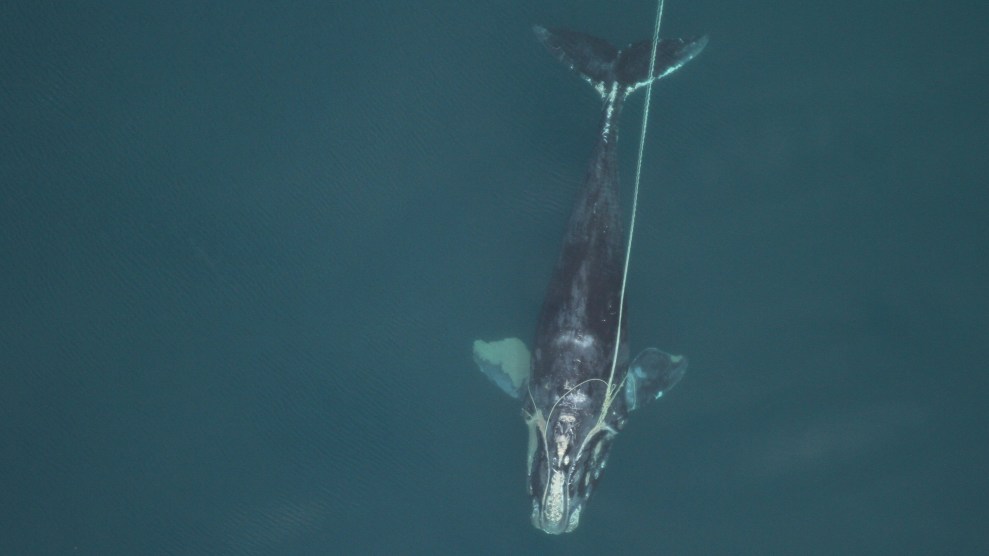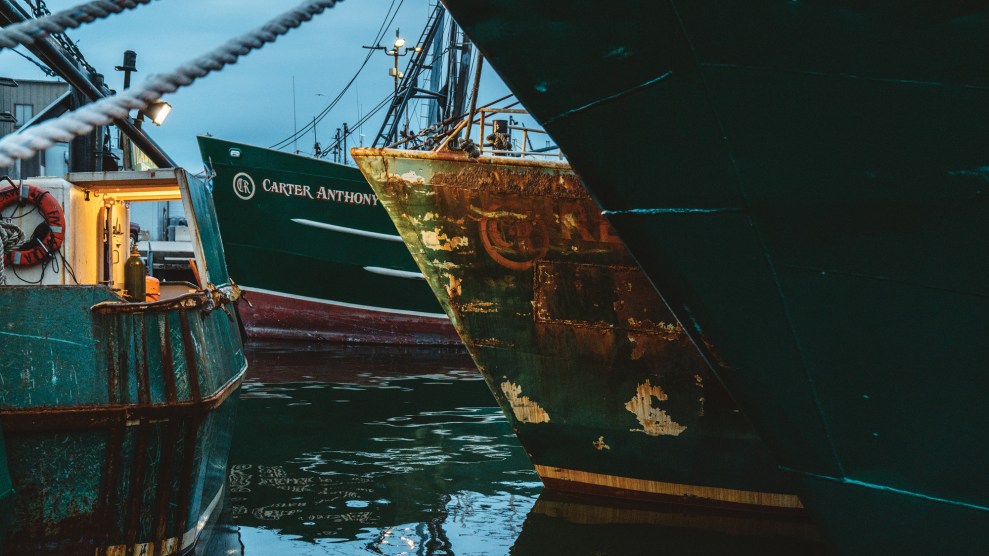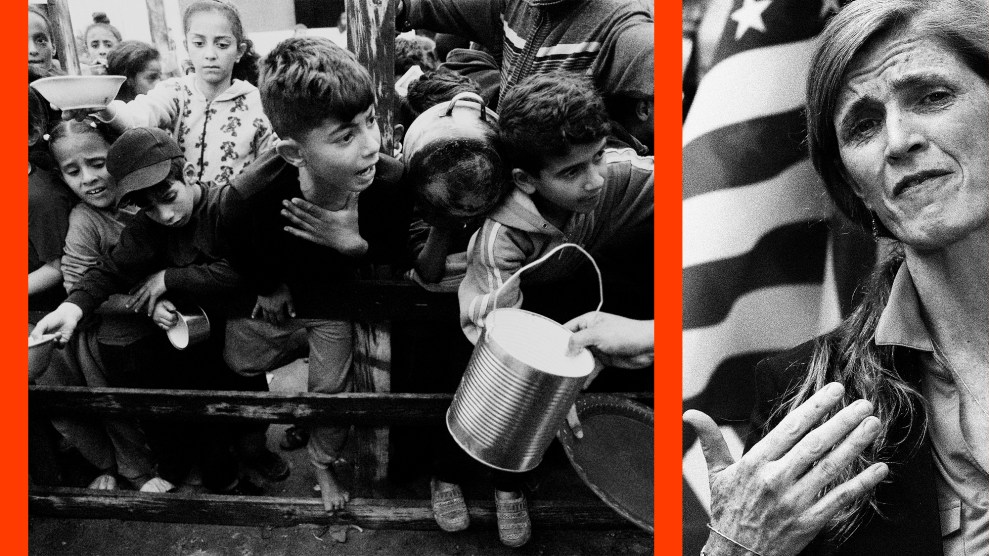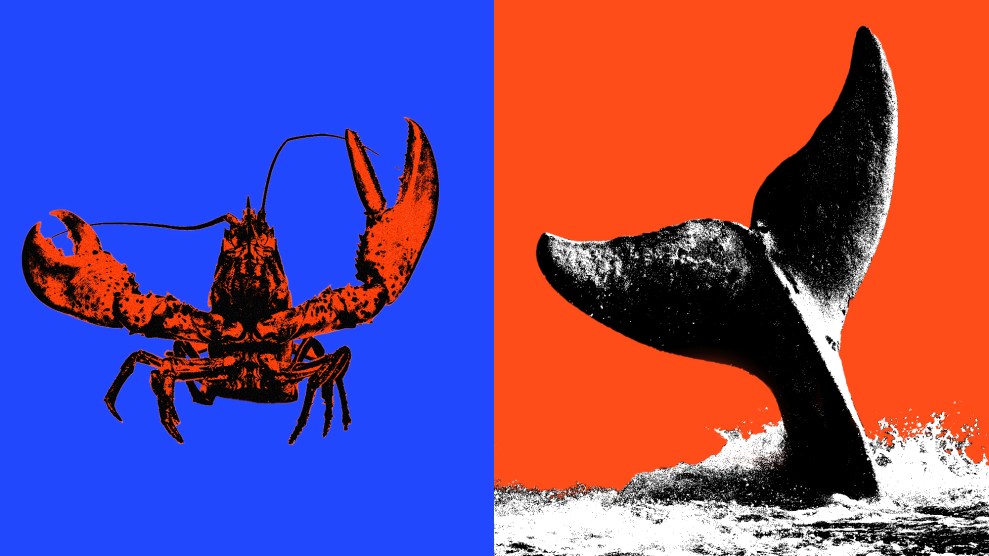
Grace Molteni/Mother Jones; Getty
The North Atlantic right whale isn’t doing well. There are fewer than 350 of these stocky baleen whales believed to be left in the wild—and the numbers are shrinking. In the last six years, vessel strikes, entanglements in fishing gear, or unknown causes have killed or injured at least 92 whales, prompting scientists to declare the die-off an “Unusual Mortality Event.” At the rate they’re dying, experts warn, the whales are at risk of disappearing forever.
But the question of who, specifically, is to blame is controversial. In September, one of the nation’s most influential voices on sustainable seafood weighed in: The Monterey Bay Aquarium announced that its Seafood Watch program, a popular consumer seafood rating guide, had red-listed several fisheries that use vertical fishing lines due to the risk they pose to North Atlantic right whales. Included in the group was the American lobster fishery. In short, the message to consumers was: If you care about the survival of whales, avoid eating lobster.
Several food suppliers listened. In September, meal kit companies HelloFresh and Blue Apron said they’d pull lobster from their menus. And last week, Whole Foods announced it would temporarily stop selling lobster fished in the Gulf of Maine after another seafood monitoring group, the Marine Stewardship Council, said that Maine lobster would lose its “sustainable” rating.
The American lobster fishery is a behemoth, particularly in Maine. Last year, according to the governor’s office, the fishery brought in a record $725 million in sales at the docks, 82 percent of the value of all of Maine’s seafood that year. The fishery employs more than 4,500 people (for reference, that’s about a third of the number of teachers in the state), and is responsible for landing about 80 percent of the country’s lobster, around 100 million pounds per year. So it was no big surprise that these new ratings didn’t sit well with the state’s fishers and their friends in Congress.
A month after the Monterey aquarium released its assessment, Maine’s entire congressional delegation—including Sens. Angus King, an Independent, and Susan Collins, a Republican, as well as Democratic Reps. Jared Golden and Chellie Pingree—announced they planned to introduce a bill to cut off all of the science institution’s federal funding. In a press release, King called the aquarium’s red listing a “baseless attack” on a “proud, sustainable fishery” and a “clear attempt to put thousands of Maine people out of work”; Collins said there was “zero evidence” behind Seafood Watch’s “absurd decision”; Pingree referred to it as “unscientific”; and Golden said it was “a slap in the face to lobstermen and their families.” Gov. Janet Mills, a Democrat, also announced support for the bill.
It’s difficult to overstate how unusual this is: Every single one of Maine’s top lawmakers put their partisan interests aside to defend lobster fishing (and eating) and condemn an aquarium on the other side of the country. The lawmakers argue that there is no proof their lobstermen were responsible for right whale deaths. In an open letter, they wrote, “[T]here has not been a known right whale entanglement with Maine lobster gear since 2004, and right whale deaths or serious injuries have never been attributed to Maine lobster gear.” They issued a similar statement in November, after Whole Foods’ decision. Marianne LaCroix, executive director of the Maine Lobster Marketing Collaborative, an organization that promotes Maine lobster, told me the red-listing “seems like a drastic step to take for a significant unknown.”
According to government data, entanglement in gear is indeed the leading cause of injury and death for right whales. And it’s easy to see why: Typically, fishers catch lobster or crab with traps on the sea floor. Ropes called “endlines” connect the traps to a buoy marker at the ocean surface, while “groundlines” connect up to dozens of traps together along the floor. Because right whales feed on zooplankton by diving with their mouths open, the gear, particularly endlines, can easily get caught in their baleen plates or wrap around their bodies. More than an estimated 80 percent of North Atlantic right whales have been entangled in fishing gear at least once, according to research reviewed by the aquarium.
But when it comes to whether Maine’s lobster fishery is to blame, the National Oceanic and Atmospheric Administration, the federal agency tasked with regulating endangered whale deaths, doesn’t seem to be on the same page as the aquarium. As the agency told me in a statement in October, “The US wild-caught American lobster fishery is sustainably managed and responsibly harvested under state and federal regulations.”
The debate, I’ll admit, left me confused. Should we all be cutting back on Maine lobster? Or was the aquarium’s listing “unscientific”? Is it true that right whale deaths have never been attributed to Maine lobster gear? And should the aquarium consider any aspect of human welfare, like jobs or the economy, in its ratings?
Let’s start with the aquarium’s decision. Seafood Watch gives one of three ratings to seafood coming into US markets: green, meaning that a particular seafood is sustainably caught and managed; yellow, which means that the researchers see some potential issues and are monitoring them; and red, which usually means, according to Jennifer Dianto Kemmerly, the Monterey Bay Aquarium’s vice president of global ocean initiatives, there is a “very severe” environmental impact associated with the seafood “and/or management’s not doing enough” to address that impact. In its rating, the aquarium considers the health of the “target stock” (in this case, the lobster population), the impact of fishing on other species (like whales) and the habitat, and the effectiveness of how the fishery is managed.
In the case of lobster, she says, management is a big problem. “NOAA is supposed to be working with the states and the industry to identify measures to reduce risk to this whale,” Dianto Kemmerly says. But the agency is not doing that, she argues, pointing out that in July, a court found the Biden administration to be in violation of the Endangered Species Act and the Marine Mammal Protection Act over a failure to limit whale deaths. By NOAA’s own estimates, the species can only sustain less than one whale death per year.
While there have been no recorded whale deaths so far in 2022, there have been five known entanglements and one vessel strike. At least one right whale, named Snow Cone, got tangled in new fishing gear this year while still carrying old gear, and is not expected to survive. A year ago, NOAA scientists determined the agency would need to work with fisheries to reduce the risk of entanglement to right whales by about 90 percent. In an emailed statement, the agency says it has since achieved about half of that goal—47 percent—with its most recent set of regulations and is currently working to revise them. NOAA has, by court order, until December 2024 to do so.
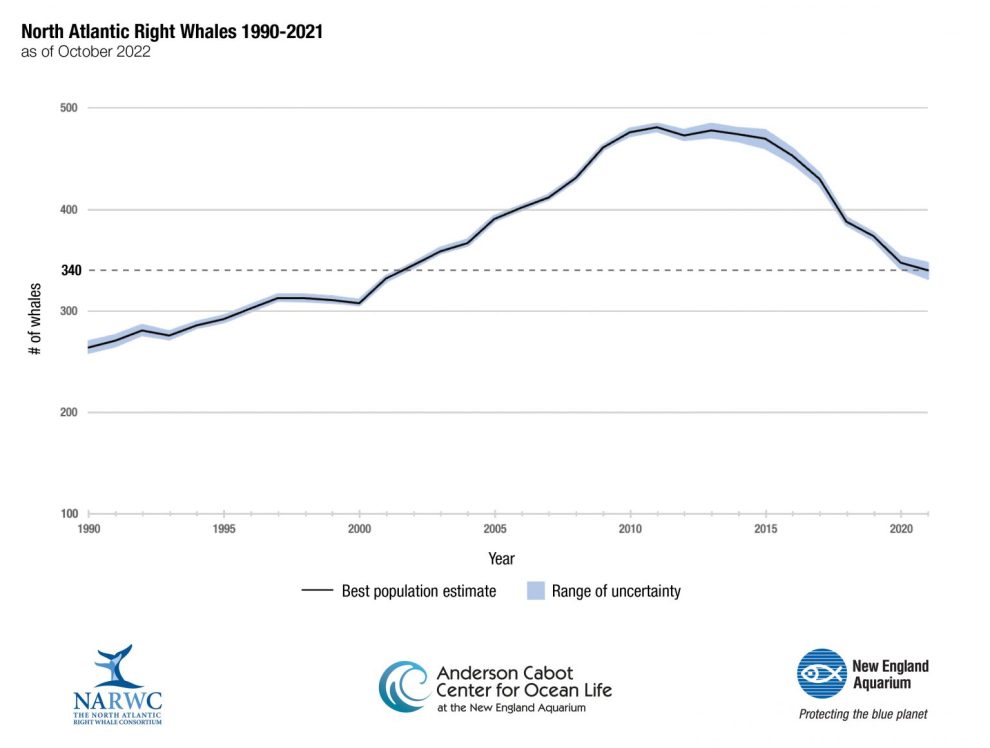
Researchers estimate that the North Atlantic right whale population for 2021 was 340 individuals.
North Atlantic Right Whale Consortium
So it’s clear these whales are in deep trouble, but are Maine’s lobster fishers directly responsible for any of these entanglements or deaths? Data is too limited to tell. According to NOAA, only about a third of right whale deaths are documented. And even for whales that are known to have died from entanglements, the gear may not be recovered with the carcasses. Or if it is, it may just look like generic rope, unattributable to any fishery. In fact, the aquarium notes, only 10 percent of documented whale deaths can be linked to a specific type of gear and only 12 percent to a specific location. So it’s true that no single right whale death has been linked to Maine lobster gear. But that’s true of almost all right whale deaths—the majority of them can’t be linked to any specific fishery.
In 2020, a law went into effect requiring Maine lobstermen to start marking their gear and making it identifiable. But entanglements can often last “a very long time, years even,” Dianto Kemmerly says, before whales die from starvation or lacerations to their skin as a result. So it may be years until a right whale dies from newly marked gear, revealing a clearer picture about whose gear is responsible. And the whales may not have that kind of time: While gear marking is helpful, says Hannah Myers, a marine biology PhD student at the University of Alaska Fairbanks focused on whale behavior and policy, “we can’t really wait on that.” “What we definitely do know,” she says, “is that right whales have been entangled in the American lobster fishery.” The vast majority of endlines are fished in the state of Maine, she notes, with an estimated 900,000 lines in the water at peak season. “That’s just a total minefield for whales to be swimming through,” she says.
While whale sightings in the Gulf of Maine have decreased over the past decade—something the Maine lawmakers note in their open letter—the whales’ movements aren’t totally understood by scientists. “Right whales are perverse beasts,” says Robert Kenney, a whale researcher at the University of Rhode Island’s Graduate School of Oceanography and a member of the Atlantic Large Whale Take Reduction Team, which advises the federal government on how to reduce entanglements. “Every time you think you know what they’re doing, they do something different.”
Even with all the uncertainty, both Myers and Kenney expressed support for the aquarium’s decision. “I think it’s totally appropriate for the Monterey Bay Aquarium to list Atlantic lobster as ‘red’ because of the bycatch risk that fishery poses to the world’s most critically endangered large whale species,” Myers said.
In all of this, it’s important to keep in mind that Seafood Watch’s assessment is an environmental one. It doesn’t take jobs or the economy into account. No part of their equation considers that all of Maine’s lobster fishers are, by law, self-employed. It doesn’t consider how many of them often come from generations of lobster fishers before them. And it certainly doesn’t consider lobster’s cultural importance to the state, like the Maine Lobster Festival or the lobster license plate or the sanctity of a well-prepared lobster roll.
But should it? What responsibility does the Monterey Bay Aquarium have to people? Some, apparently. In 2018, the aquarium, along with two other organizations, Liberty Shared and the Sustainable Fisheries Partnership, released an early version of what is now the Seafood Social Risk Tool. Its purpose is to help businesses “take the first steps in identifying and managing the risk of human rights abuses in their seafood supply chains.” So the aquarium recognizes human impacts in some lists. When I asked Dianto Kemmerly if she thought Seafood Watch should take people’s economic livelihoods (on top of their human rights) into account, she emphasized in an emailed response that the mission of the aquarium is to “inspire conservation of the ocean” and that Seafood Watch helps ensure “people and the planet can thrive for the long-term.” She said that there are currently no plans to include economic indicators in the organization’s assessments.
A few other organizations have taken that step. In 2015, Fair Trade USA, a certifier of equitably made products in North America, launched a seafood label that measures socioeconomic factors, like safe working conditions, ethical labor practices, and “sustainable livelihoods,” in addition to environmental standards.
But combining ecological factors with social and economic ones can be tricky. For instance, asks Martin Smith, a professor and marine economist at Duke University, “Can you put something like Maine lobster on the green list for its labor practices…and still have it on the red list for your conservation concern?” This would force eco-labels and ratings programs to choose between conflicting values—in this case, whales’ lives and people’s livelihoods. “Is one whale worth 1,000 jobs? 2,000 jobs? Five communities? 10 communities?” says Frank Asche, a natural resource economist at the University of Florida. “Nobody knows that. And nobody really want to make that decision.” And it’s not just the right whales: A handful of other species, including the Pacific leatherback sea turtle, the Steller sea lion, and the vaquita, one of the world’s smallest porpoises, have also been indirectly threatened by fishing activity, sparking similar strife over jobs and animal survival.
Regardless of the aquarium’s recommendation, for the North Atlantic right whale to avoid extinction, according to Kenney and Myers, there simply needs to be a drastic reduction in the amount of vertical fishing line in the ocean. Getting whale deaths below NOAA’s threshold of one animal per year, “is achievable,” Kenney says, “if we take rope out of the water.”
Solutions may not have to hurt fishers’ bottom lines. Some lobster fishers are currently experimenting with “ropeless” or “on-demand” fishing gear, a technology that can raise traps off the seafloor with popup buoys or inflatable lift bags without requiring a marker at the surface, eliminating virtually all risk to whales. Earlier this year, NOAA released a plan to encourage the adoption of the technology and is currently allowing experimenters to try it out through its gear library. But on-demand gear is expensive, NOAA wrote in its report, and fishers may not be able to afford it on their own without “financial incentives” or “supplemental funding.”
Other fixes could include reducing rope strength to make it easier for whales to break free if they do become entangled, or scaling back the number of endlines in the water, which would reduce the chances of entanglement in the first place.
Whatever the cure, it will need to happen quickly. As Myers put it, “One of the most important things for right whales right now is time. We’re moving towards solutions. But we have very, very little time left to act.”
This post has been updated to include additional reporting.

